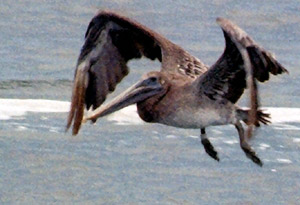Vertebrate Flight
INTRODUCTION: HOW DO THEY DO IT?
|
|
 Pelican. Photo by Mary Hollinger, National Oceanic and Atmospheric Administration / Department of Commerce. |
Flight is an amazing accomplishment, evolved only three times in the 500 million years of vertebrate history. By contrast, the invertebrates have only evolved flight once: in the insects, which were the first animals to evolve flight. We won't discuss insect flight here, as the diversity of flight types seen in insects really deserves a set of exhibits all its own. Good sources about insect flight include "The Biomechanics of Insect Flight", by Robert Dudley, and "Solving the Mystery of Insect Flight" by Michael Dickinson (Scientific American, June, 2001). However, the same rules that govern vertebrate flight also apply to insect flight, so you can also use the information given here when considering insects. The question is, how do vertebrates manage to overcome the weight of their bodies in order to take to the skies? Let's look at how different animals move through the air, and then see what flight is all about.
Types of Aerial LocomotionTechnically, there are four generalized "levels" of motion through the air if you are a vertebrate (or, for that matter, any other organism). If you can do one of the "upper levels", you can probably succeed at any of the "lower levels". These levels, and a basic description of each, follow:
- Parachuting: In the most general definition of parachuting, any animal can parachute — basically, falling is parachuting (don't try this at home). Parachuting is defined as descent with an angle between the direction of parachuting and the horizontal axis of greater than 45 degrees. Better parachuters fall more slowly, because they have a lot of surface area relative to their weight, and so drag forces are higher, which slows down the object's descent. So parachuting focuses on maximizing drag forces in order to slow the object's fall. Many plants use parachuting to disperse their seeds, and of course humans use parachutes when jumping out of planes and such.
Gliding: Gliding is basically a more elaborate form of parachuting; it is when the angle of descent is less than 45 degrees (gliders tend to go longer horizontal distances as a result). Gliding works by having a gliding airfoil design that generates lift forces, keeping the animal in the air longer. Streamlining is important in gliders to reduce drag forces. Gliding is actually common among vertebrates; several reptiles, mammals, and even ray-finned fish have evolved gliding. In fact, most vertebrate groups have living and/or extinct members that could glide.
Flight: You can immediately tell if an animals flies by looking at it when it is moving — if it flaps its wings, then it is flying (assisted aerial motion, or true (powered) flight). Gliders and parachuters don't move their "wings"; they passively descend through the air. True flyers have more control over their descent — they can flap their wings to produce thrust for added speed and lift for added height. See the diagram above for a depiction of how different force vectors created during flight describe the motion of the flyer. True flyers can thus move horizontally or even ascend at a steady speed, unlike gliders and parachuters (unless a strong wind carries one up). We'll look at exactly how flight works in the next exhibit. True flight has only been evolved in vertebrates three times: in the pterosaurs, the birds, and the bats (in chronological order). This will be discussed in our final exhibits; we'll give you some vital background information first.
Soaring: Soaring animals appear to be only gliding because they don't flap their wings. Soaring is actually very different, and requires specific physiological and morphological adaptations. Soaring uses the energy of the surrounding air (e.g., rising warm air, or thermals) to keep the animal at a constant altitude. It is often described as analogous to "falling down an up escalator." A soaring animal does not flap its wings except to take off or to land, or to make slight adjustments while soaring. Only particularly large animals can be efficient soarers; we'll discuss why later. This form of flight has only been achieved by a few animals over the course of evolution; the larger pterosaurs and some large birds are the only known soaring animals.

Sources:
• Padian, K. 1985. The origins and aerodynamics of flight in extinct vertebrates. Palaeontology 28(3): 413-433.
• Hildebrand, M. 1995. Analysis of Vertebrate Structure. 4th ed. John Wiley & Sons, Inc., New York. 657 pp.
• Gauthier, J.A., and K. Padian. 1989. The Origin of Birds and the Evolution of Flight. Pp. 121-133 in K. Padian
and D.J. Chure (eds.), The Age of Dinosaurs: Short Courses in Paleontology Number 2. The Paleontological Society.
Next: The Physics of Flight